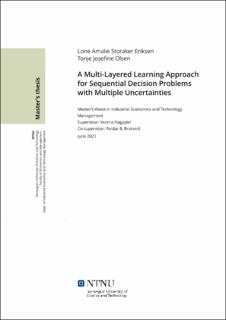| dc.contributor.advisor | Hagspiel, Verena | |
| dc.contributor.advisor | Bratvold, Reidar Brumer | |
| dc.contributor.author | Eriksen, Lone Amalie Storaker | |
| dc.contributor.author | Olsen, Tonje Josefine | |
| dc.date.accessioned | 2021-10-05T17:19:33Z | |
| dc.date.available | 2021-10-05T17:19:33Z | |
| dc.date.issued | 2021 | |
| dc.identifier | no.ntnu:inspera:85279552:85282688 | |
| dc.identifier.uri | https://hdl.handle.net/11250/2787833 | |
| dc.description.abstract | I denne masteroppgaven bidrar vi til realopsjonslitteraturen ved å kombinere Bayesiansk læring og Least Squares Monte Carlo (LSM)-metoden. I tillegg til den læringen som oppstår over tid med stokastiske prosesser brukt i den tradisjonelle LSM-metoden, så vil beslutningstakeren periodisk motta signaler med informasjon om prosessenes hyperparametere. Bayesiansk inferens er brukt til å oppdatere beslutningstakerens tro på hyperparameterne, som videre er brukt til å angi distribusjonene i de stokastiske prosessene. Behovet for å oppdatere parameterne kommer fra regimeskifter, indikert av signalene beslutningstakeren mottar. Vi gir videre innsikt i beslutningskonteksten ved å undersøke hvordan ulik tro og parametervalg påvirker den optimale beslutningsstrategien i et illustrativt eksempel ved bruk av sensitivitetsanalyse.
Vi observerer at å motta signaler og oppdatere troen kan betydelig påvirke investeringsmulighetens verdi og beslutningsstrategi. Hvis signalene avviker betydelig fra den opprinnelige troen, så oppnår beslutningstakeren ofte en annen investeringsverdi og beslutningsstrategi. Signalene vil ha en større effekt når beslutningstakerens usikkerhet er høy. Metodologien er allsidig og fleksibel, og den er relevant for et stort utvalg applikasjoner. | |
| dc.description.abstract | In this paper, we contribute to the existing real options valuation literature by adding Bayesian updating to the Least Squares Monte Carlo (LSM) solution approach. In addition to the learning that occurs over time from the stochastic processes used in the LSM approach, the decision maker will periodically receive signals providing information about the hyperparameters of the stochastic processes. Bayesian inference is used to update the decision maker’s prior beliefs about the hyperparameters, which are used to set the distributions in the stochastic processes. The need for parameter updates arises from regime shifts as indicated by the signals available to the decision maker. We provide further insights into the decision context by examining how different beliefs and parameter choices affect the optimal decision policy for an illustrative example using sensitivity analysis.
We find that receiving signals and updating the beliefs can notably impact the investment value and decision policy for the investment problem. If the signals differ sufficiently from the prior beliefs, a different decision policy and investment value are often reached. The signals will have a more prominent effect when the decision maker’s uncertainty is high. The methodology is flexible and versatile and is applicable to a broad set of problems. | |
| dc.language | eng | |
| dc.publisher | NTNU | |
| dc.title | A Multi-Layered Learning Approach for Sequential Decision Problems with Multiple Uncertainties | |
| dc.type | Master thesis | |
